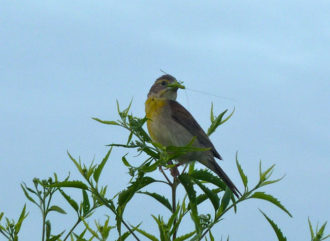MISSISSIPPI STATE, Mississippi – Native warm season grasses excel over more traditional commercial grass varieties when it comes to grazing livestock and promoting wildlife conservation, based on the results of a two-year Mississippi State University agroecology study.
The study, funded by a Southern Sustainable Agriculture Research & Education (SSARE) Graduate Student grant, compared native warm season forages (an Indian grass monoculture, and an Indian grass, big bluestem, and little bluesteam polyculture) to a bermudagrass/tall fescue mix to determine whether converting bermudagrass/tall fescue to native warm season grasses is economical for livestock producers interested in conservation practices.
MSU graduate student Adrian Monroe found that native warm season grasses yielded higher forage quality than the bermudagrass/tall fescue mix. Average daily weight gain of livestock grazing on the bermudagrass/tall fescue mix was 32 percent lower the first year of study and 40 percent lower the second year of study compared to the native warm season grasses.
“The crude protein was higher in the bermudagrass/tall fescue mix, but that might be in response to higher fertilizer rates,” said Monroe. “Dry matter yield was higher among native grass pastures, specifically the Indian grass monoculture, which means we got greater productivity with the native grass pastures.”
Monroe, who is now pursuing a post doctorate at Colorado State University, said that establishment costs of native warm season grasses – 8-9 times greater than the initial maintenance cost for bermudagrass – may turn off many livestock producers. However, the study revealed that average daily weight gain of cattle on native warm season grasses, particularly for the Indian grass monoculture, yielded up to 36 percent marginal rates of return.
“In other words, for every $1 invested in native warm season grass establishment, producers would recoup their investment plus 36 cents in additional revenue over a bermudagrass/tall fescue grazing system,” said Monroe.
In addition to native warm season grasses serving as a viable grazing alternative, researchers found that Indian grass, big bluestem and little bluestem provide favorable habitat for breeding birds, such as the Dickcissel – a sparrow-like grassland bird.
“We saw an increase in nest density and survivorship for Dickcissel nests in native warm season grass polyculture pastures, yielding greater production of fledglings per hectare compared with bermudagrass/tall fescue pastures,” said Monroe. “Native warm season grass pastures may mimic native prairies, with bunch grasses providing nesting structure, whereas bermudagrass and tall fescue offer few suitable nest sites for Dickcissels.”
Researchers focused on Dickcissels in the study because they are common in Mississippi, yet their populations are declining.
Depending on the overall goals of the farming operation, native warm season grasses may be an alternative to bermudagrass for livestock producers interested in diversifying their grazing operation while enhancing biodiversity.
The SSARE-funded project, “Evaluating Conversion of Bermudagrass Pastures to Native Warm Season Grass: Profitability analysis and response of wildlife and imported fire ants (GS12-116),” can be found in the national SARE projects database.
--30--
Published by the Southern Region of the Sustainable Agriculture Research and Education (SARE) program. Funded by the USDA National Institute of Food and Agriculture (NIFA), Southern SARE operates under cooperative agreements with the University of Georgia, Fort Valley State University, and the Kerr Center for Sustainable Agriculture to offer competitive grants to advance sustainable agriculture in America's Southern region.
